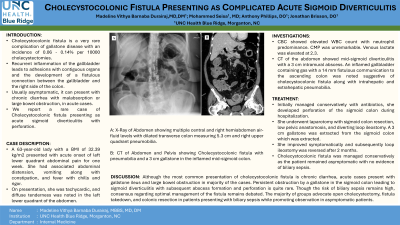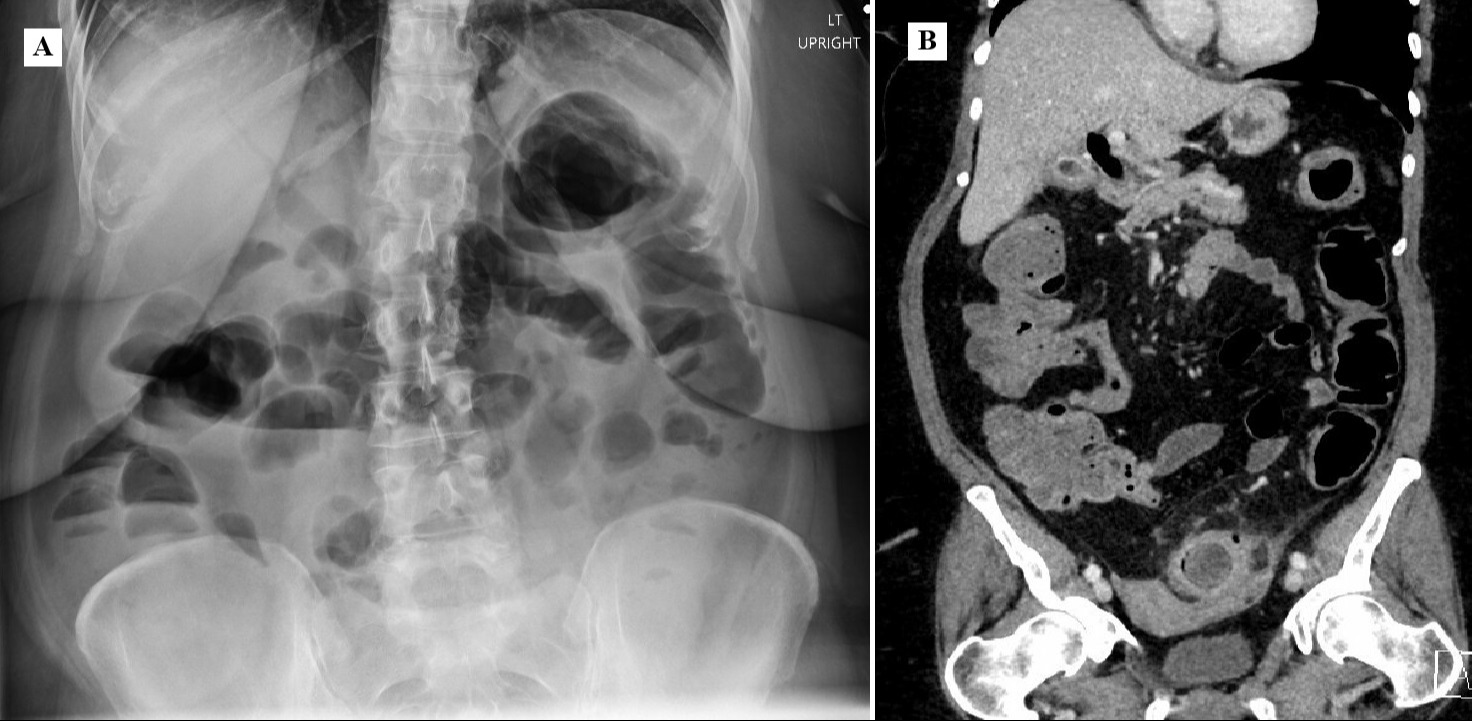Sunday Poster Session
Category: Biliary/Pancreas
P0088 - Cholecystocolonic Fistula Presenting as Complicated Acute Sigmoid Diverticulitis
Sunday, October 27, 2024
3:30 PM - 7:00 PM ET
Location: Exhibit Hall E

Has Audio
- MB
Madeline Vithya Barnaba Durairaj, MBBS, MD, DM
UNC Health Blue Ridge
Prairie Village, KS
Presenting Author(s)
Madeline Vithya Barnaba Durairaj, MBBS, MD, DM1, Mohamed O. Seisa, MD2, Anthony Philips, DO2, Jonathan Brisson, DO2
1UNC Health Blue Ridge, Prairie Village, KS; 2UNC Health Blue Ridge, Morganton, NC
Introduction: Cholecystocolonic fistula is a very rare complication of gallstone disease with an incidence of 0.06 - 0.14% per 10000 cholecystectomies. Recurrent inflammation of the gallbladder leads to adhesions with contiguous organs and the development of a fistulous connection between the gallbladder and the right side of the colon. Usually asymptomatic, it can present with chronic diarrhea with malabsorption or large bowel obstruction, in acute cases. We report a rare case of Cholecystocolonic fistula presenting as acute sigmoid diverticulitis with perforation.
Case Description/Methods: A 63-year-old lady with a BMI of 32.39 kg/m2 presented with acute onset of left lower quadrant abdominal pain for one week. She had associated abdominal distension, vomiting along with constipation, and fever with chills and rigor. On presentation, she was tachycardic, and diffuse tenderness was noted in the left lower quadrant of the abdomen. CBC showed elevated WBC count with neutrophil predominance. CMP was unremarkable. Venous lactate was elevated at 2.3. CT of the abdomen showed mid-sigmoid diverticulitis with a 3 cm intramural abscess. An inflamed gallbladder containing gas with a 14 mm fistulous communication to the ascending colon was noted suggestive of cholecystocolonic fistula along with intrahepatic and extrahepatic pneumobilia. Initially managed conservatively with antibiotics, she developed perforation of the sigmoid colon during hospitalization. She underwent laparotomy with sigmoid colon resection, low pelvic anastomosis, and diverting loop ileostomy. A 3 cm gallstone was extracted from the sigmoid colon which was extracted. She improved symptomatically and subsequently underwent a reversal of the loop ileostomy after 2 months. Cholecystocolonic fistula was managed conservatively as the patient remained asymptomatic with no evidence of biliary sepsis.
Discussion: Although the most common presentation of cholecystocolonic fistula is chronic diarrhea, acute cases present with gallstone ileus and large bowel obstruction in the majority of the cases. Persistent obstruction by a gallstone in the sigmoid colon leading to sigmoid diverticulitis with subsequent abscess formation and perforation is quite rare. Though the risk of biliary sepsis remains high, consensus regarding optimal management of the fistula remains debated. The majority of groups advocate open cholecystectomy, fistula takedown, and colonic resection in patients presenting with biliary sepsis while promoting observation in asymptomatic patients.

Disclosures:
Madeline Vithya Barnaba Durairaj, MBBS, MD, DM1, Mohamed O. Seisa, MD2, Anthony Philips, DO2, Jonathan Brisson, DO2. P0088 - Cholecystocolonic Fistula Presenting as Complicated Acute Sigmoid Diverticulitis, ACG 2024 Annual Scientific Meeting Abstracts. Philadelphia, PA: American College of Gastroenterology.
1UNC Health Blue Ridge, Prairie Village, KS; 2UNC Health Blue Ridge, Morganton, NC
Introduction: Cholecystocolonic fistula is a very rare complication of gallstone disease with an incidence of 0.06 - 0.14% per 10000 cholecystectomies. Recurrent inflammation of the gallbladder leads to adhesions with contiguous organs and the development of a fistulous connection between the gallbladder and the right side of the colon. Usually asymptomatic, it can present with chronic diarrhea with malabsorption or large bowel obstruction, in acute cases. We report a rare case of Cholecystocolonic fistula presenting as acute sigmoid diverticulitis with perforation.
Case Description/Methods: A 63-year-old lady with a BMI of 32.39 kg/m2 presented with acute onset of left lower quadrant abdominal pain for one week. She had associated abdominal distension, vomiting along with constipation, and fever with chills and rigor. On presentation, she was tachycardic, and diffuse tenderness was noted in the left lower quadrant of the abdomen. CBC showed elevated WBC count with neutrophil predominance. CMP was unremarkable. Venous lactate was elevated at 2.3. CT of the abdomen showed mid-sigmoid diverticulitis with a 3 cm intramural abscess. An inflamed gallbladder containing gas with a 14 mm fistulous communication to the ascending colon was noted suggestive of cholecystocolonic fistula along with intrahepatic and extrahepatic pneumobilia. Initially managed conservatively with antibiotics, she developed perforation of the sigmoid colon during hospitalization. She underwent laparotomy with sigmoid colon resection, low pelvic anastomosis, and diverting loop ileostomy. A 3 cm gallstone was extracted from the sigmoid colon which was extracted. She improved symptomatically and subsequently underwent a reversal of the loop ileostomy after 2 months. Cholecystocolonic fistula was managed conservatively as the patient remained asymptomatic with no evidence of biliary sepsis.
Discussion: Although the most common presentation of cholecystocolonic fistula is chronic diarrhea, acute cases present with gallstone ileus and large bowel obstruction in the majority of the cases. Persistent obstruction by a gallstone in the sigmoid colon leading to sigmoid diverticulitis with subsequent abscess formation and perforation is quite rare. Though the risk of biliary sepsis remains high, consensus regarding optimal management of the fistula remains debated. The majority of groups advocate open cholecystectomy, fistula takedown, and colonic resection in patients presenting with biliary sepsis while promoting observation in asymptomatic patients.

Figure: A. X-Ray of Abdomen showing multiple central and right hemiabdomen air-fluid levels with dilated transverse colon measuring 5.3 cm and right upper quadrant pneumobilia.
B. CT of Abdomen and Pelvis showing Cholecystocolonic fistula with pneumobilia and a 3 cm gallstone in the inflamed mid-sigmoid colon.
B. CT of Abdomen and Pelvis showing Cholecystocolonic fistula with pneumobilia and a 3 cm gallstone in the inflamed mid-sigmoid colon.
Disclosures:
Madeline Vithya Barnaba Durairaj indicated no relevant financial relationships.
Mohamed Seisa indicated no relevant financial relationships.
Anthony Philips indicated no relevant financial relationships.
Jonathan Brisson indicated no relevant financial relationships.
Madeline Vithya Barnaba Durairaj, MBBS, MD, DM1, Mohamed O. Seisa, MD2, Anthony Philips, DO2, Jonathan Brisson, DO2. P0088 - Cholecystocolonic Fistula Presenting as Complicated Acute Sigmoid Diverticulitis, ACG 2024 Annual Scientific Meeting Abstracts. Philadelphia, PA: American College of Gastroenterology.
